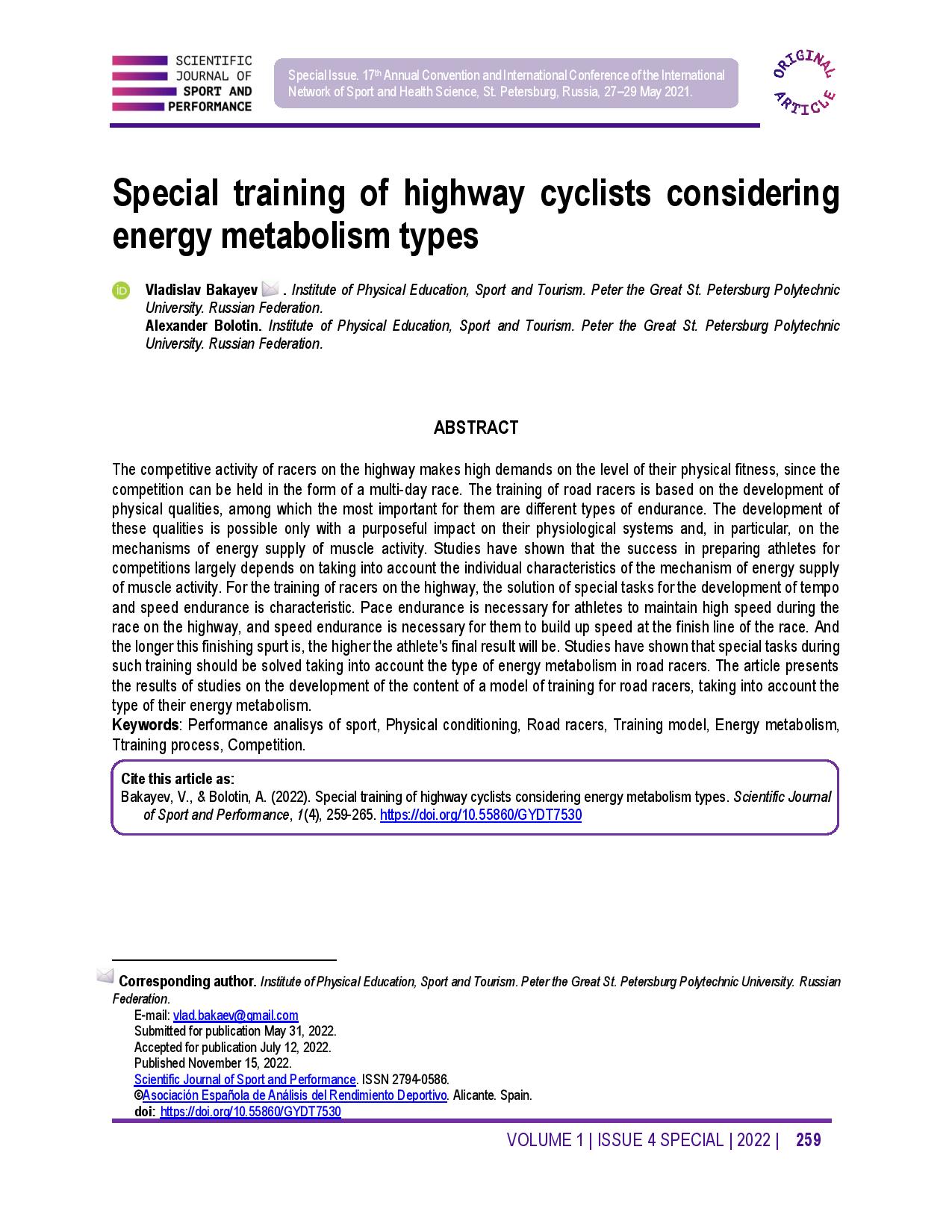Special training of highway cyclists considering energy metabolism types
Main Article Content
Abstract
The competitive activity of racers on the highway makes high demands on the level of their physical fitness, since the competition can be held in the form of a multi-day race. The training of road racers is based on the development of physical qualities, among which the most important for them are different types of endurance. The development of these qualities is possible only with a purposeful impact on their physiological systems and, in particular, on the mechanisms of energy supply of muscle activity.
The analysis of the literature showed that in most of the works devoted to the preparation of racers on the highway, there is no necessary scientific information characterizing the features of the energy supply of their muscular activity during preparation for multi-day races. This greatly limits the possibilities for differentiating the means and methods of developing different types of endurance in the process of training. The issues of application of methods for the development of endurance among racers on the highway, where the differentiation criterion would be different types of energy metabolism, are also insufficiently developed. The existing system of preparation of racers on the highway for competitions is characterized by insufficient consideration of the peculiarities of the mechanism of energy supply of muscular activity in the training process. Its main drawback is its general approach to training road riders. Coaches in their work with athletes are guided solely by their personal experience of preparing road riders for competitions.
Article Details

This work is licensed under a Creative Commons Attribution-NonCommercial-ShareAlike 4.0 International License.
References
Bakayev, V., & Bolotin, A. (2020). Differentiated Training Model for Marathon Runners on Building Tempo and Speed Endurance Based on the Types of Energy Metabolism. Sport Mont, 18(3), 31-34. doi: 10.26773/smj.201011 DOI: https://doi.org/10.26773/smj.201011
Bakayev, V., Bolotin, A., & You, C. (2018). Reaction of vegetative nervous system to loads in female long-distance runners with different fitness level. Journal of Human Sport and Exercise, 13(2proc), S245-S252. doi:https://doi.org/10.14198/jhse.2018.13.Proc2.09 DOI: https://doi.org/10.14198/jhse.2018.13.Proc2.09
Bolotin A. and Bakayev V. (2017). Method for Training of Long Distance Runners Taking into Account Bioenergetic Types of Energy Provision for Muscular Activity. In Proceedings of the 5th International Congress on Sport Sciences Research and Technology Support, pp. 126-131. DOI: https://doi.org/10.5220/0006516101260131
Costa, M.J., Bragada, J.A., Mejias, J.E., Louro, H., Marinho, D.A., Silva, A.J., & Barbosa, T.M. (2012). Tracking the performance, energetics and biomechanics of international versus national level swimmers during a competitive season. European Journal of Applied Physiology, 112, 811–820. DOI: https://doi.org/10.1007/s00421-011-2037-6
Dushanin, S. A. (1986). System of multi-factor Express diagnostics of functional readiness of athletes at current and operational medical and pedagogical control: Physical Culture and sport.
Ganapolsky, V.P., Matytsin, V.O., & Rodichkin, P.V. (2019). Complex use of hypoxic training and pharmacological corrections to improve performance of mountaineers. Teoriya i Praktika Fizicheskoy Kultury, (3), p. 34.
Kumstát, M., Struhár, I., Hlinský, T., & Thomas, A. (2019). Effects of immediate post-exercise recovery after a high intensity exercise on subsequent cycling performance. Journal of Human Sport and Exercise, 14(2), 399-410. doi:https://doi.org/10.14198/jhse.2019.142.12 DOI: https://doi.org/10.14198/jhse.2019.142.12
Maciejczyk, M., Wiecek, M., Szymura, J., Szygula, Z., & Brown, L.E. (2015). Influence of Increased Body Mass and Body Composition on Cycling Anaerobic Power. The Journal of Strength and Conditioning Research, 29(1), 58–65. DOI: https://doi.org/10.1519/JSC.0000000000000727
Novak, A.R., & Dascombe, B.J. (2014). Physiological and performance characteristics of road, mountain bike and BMX cyclists. Journal of Science and Cycling, 3(3), 9–16.
Porter, Fenton, and Reed. (2019). The effects of hyperoxia on repeated sprint cycling performance & muscle fatigue. Journal of Science and Medicine in Sport. https://doi.org/10.1016/j.jsams.2019.07.001 DOI: https://doi.org/10.1016/j.jsams.2019.07.001
Prieur, and Mucci. (2013). Effect of high-intensity interval training on the profile of muscle deoxygenation heterogeneity during incremental exercise. European Journal of Applied Physiology, 113(1), 249– 257. https://doi.org/10.1007/s00421-012-2430-9 DOI: https://doi.org/10.1007/s00421-012-2430-9
Spencer, M., Bishop, D., Dawson, B., & Goodman, C. (2005). Physiological and Metabolic Responses of Repeated-Sprint Activities: Specific to Field-Based Team Sports. Sports Med, 35(12), 1025–1044. https://doi.org/10.2165/00007256-200535120-00003 DOI: https://doi.org/10.2165/00007256-200535120-00003
Spierer, D. K., Goldsmith, R., Baran, D. A., Hryniewicz, K., & Katz, S. D. (2004). Effects of active vs. passive recovery on work performed during serial supramaximal exercise tests. Int J Sports Med, 25(2), 109–114. https://doi.org/10.1055/s-2004-819954 DOI: https://doi.org/10.1055/s-2004-819954
Sousa, A., Figueiredo, P., Zamparo, P., Vilas-Boas, J.P., & Fernandes, R.J. (2013). Anaerobic alactic energy assessment in middle distance swimming. European Journal of Applied Physiology, 113(8), 2153–2158. DOI: https://doi.org/10.1007/s00421-013-2646-3




